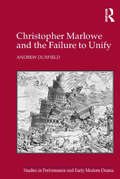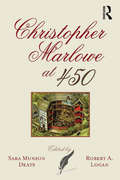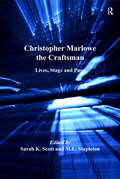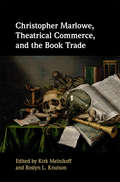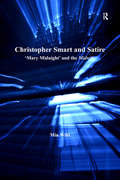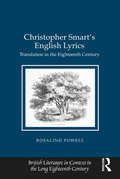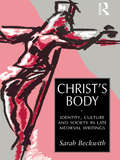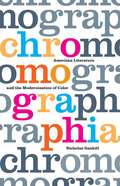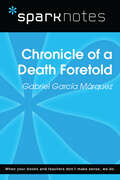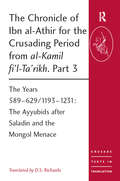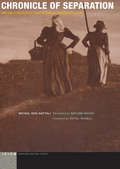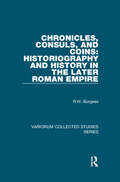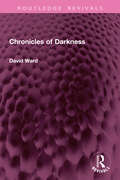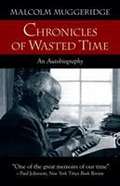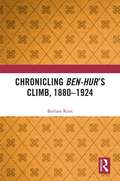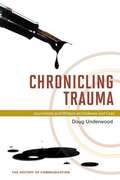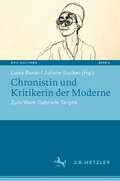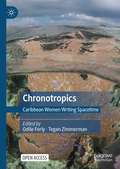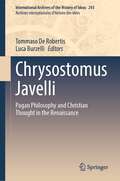- Table View
- List View
Christopher Marlowe and the Failure to Unify (Studies in Performance and Early Modern Drama)
by Andrew DuxfieldIn this sustained full length study of Marlowe's plays, Andrew Duxfield argues that Marlovian drama exhibits a marked interest in unity and unification, and that in doing so it engages with a discourse of anxiety over social discord that was prominent in the 1580s and 1590s. In combination with the ambiguity of the plays, he suggests, this focus produces a tension that both heightens dramatic effect and facilitates a cynical response to contemporary evocations of and pleas for unity. This book has three main aims. Firstly, it establishes that Marlowe’s tragedies exhibit a profound interest in the process of reduction and the ideal of unity. Duxfield shows this interest to manifest itself in different ways in each of the plays. Secondly, it identifies this interest in unity and unification as an engagement in a cultural discourse that was particularly prevalent in England during Marlowe’s writing career; during the late 1580s and early 1590s heightened inter-confessional tension, the threat and reality of foreign invasion and public puritan dissent in the form of the Marprelate controversy provoked considerable public anxiety about social discord. Thirdly, the book considers the plays’ focus on unity in relation to their marked ambiguity; throughout all of the plays, unifying ideals and reductive processes are consistently subject to renegotiation with, or undercut entirely by, the complexity and ambiguity of the dramas in which they feature. Duxfield’s focus on unity as a theme throughout the plays provides a new lens through which to examine the place of Marlowe’s work in its cultural moment.
Christopher Marlowe at 450
by Sara Munson Deats Robert A. LoganThere has never been a retrospective on Christopher Marlowe as comprehensive, complete and up-to-date in appraising the Marlovian landscape. Each chapter has been written by an eminent, international Marlovian scholar to determine what has been covered, what has not, and what scholarship and criticism will or might focus on next. The volume considers all of Marlowe’s dramas and his poetry, including his translations, as well as the following special topics: Critical Approaches to Marlowe; Marlowe’s Works in Performance; Marlowe and Theatre History; Electronic Resources for Marlovian Research; and Marlowe’s Biography. Included in the discussions are the native, continental, and classical influences on Marlowe and the ways in which Marlowe has interacted with other contemporary writers, including his influence on those who came after him. The volume has appeal not only to students and scholars of Marlowe but to anyone interested in Renaissance drama and poetry. Moreover, the significance for readers lies in the contributors’ approaches as well as in their content. Interest in the biography of Christopher Marlowe and in his works has bourgeoned since the turn of the century. It therefore seems especially appropriate at this time to present a comprehensive assessment of past and present traditional and innovative lines of inquiry and to look forward to future developments.
Christopher Marlowe in Context
by Emily C. Bartels Emma SmithThe life and death of Christopher Marlowe has long been shrouded in mystery and subject to speculation. One of the foremost dramatists of his day, Marlowe and his writings exerted an influence not only on the work of his contemporaries, including Shakespeare, but also on literary culture to the present. Setting Marlowe's writings in their historical context, this collection showcases the most exciting critics writing on critical and contextual approaches to his poems and plays, discussing both major and lesser-known works. In three sections, 'Marlowe's works', 'Marlowe's world', and 'Marlowe's reception,' short chapters tell a story ranging from classical literature through to modern cinema. Other topics covered include religion, geography, audience, and women. Chapters on the critics and Marlowe now show how and why his works continue to resonate and a comprehensive further reading list provides helpful suggestions for those who want to find out more.
Christopher Marlowe the Craftsman: Lives, Stage, and Page
by M.L. StapletonContributions to this volume explore the idea of Marlowe as a working artist, in keeping with John Addington Symonds' characterization of him as a "sculptor-poet." Throughout the body of his work-including not only the poems and plays, but also his forays into translation and imitation-a distinguished company of established and emerging literary scholars traces how Marlowe conceives an idea, shapes and refines it, then remakes and remodels it, only to refashion it further in his writing process. These essays necessarily overlap with one another in the categories of lives, stage, and page, which signals their interdependent nature regarding questions of authorship, theater and performance history, as well as interpretive issues within the works themselves. The contributors interpret and analyze the disputed facts of Marlowe's life, the textual difficulties that emerge from the staging of his plays, the critical investigations arising from analyses of individual works, and their relationship to those of his contemporaries. The collection engages in new ways the controversies and complexities of its subject's life and art. It reflects the flourishing state of Marlowe studies as it shapes the twenty-first century conception of the poet and playwright as master craftsman.
Christopher Marlowe, Theatrical Commerce, and the Book Trade
by Kirk Melnikoff Roslyn L. KnutsonPresenting the first exploration of Christopher Marlowe's complex place in the canon, this collection reads Marlowe's work against an extensive backdrop of repertory, publication, transmission, and reception. Wide-ranging and thoughtful chapters consider Marlowe's deliberate engagements with the stage and print culture, the agents and methods involved in the transmission of his work, and his cultural reception in the light of repertory and print evidence. With contributions from major international scholars, the volume considers all of Marlowe's oeuvre, offering illuminating approaches to his extended animation in theatre and print, from the putative theatrical debut of Tamburlaine in 1587 to the most current editions of his work.
Christopher Smart and Satire: 'Mary Midnight' and the Midwife
by Min WildChristopher Smart and Satire explores the lively and idiosyncratic world of satire in the eighteenth-century periodical, focusing on the way that writers adopted personae to engage with debates taking place during the British Enlightenment. Taking Christopher Smart's audacious and hitherto underexplored Midwife, or Old Woman's Magazine (1750-1753) as her primary source, Min Wild provides a rich examination of the prizewinning Cambridge poet's adoption of the bizarre, sardonic 'Mary Midnight' as his alter-ego. Her analysis provides insights into the difficult position in which eighteenth-century writers were placed, as ideas regarding the nature and functions of authorship were gradually being transformed. At the same time, Wild also demonstrates that Smart's use of 'Mary Midnight' is part of a tradition of learned wit, having an established history and characterized by identifiable satirical and rhetorical techniques. Wild's engagement with her exuberant source materials establishes the skill and ingenuity of Smart's often undervalued, multilayered prose satire. As she explores Smart's use of a peculiarly female voice, Wild offers us a picture of an ingenious and ribald wit whose satirical overview of society explores, overturns, and anatomises questions of gender, politics, and scientific and literary endeavors.
Christopher Smart's English Lyrics: Translation in the Eighteenth Century (British Literature in Context in the Long Eighteenth Century)
by Rosalind PowellIn the first full-length study of Christopher Smart’s translations and the place and function of translation in Smart’s poetry, Rosalind Powell proposes a new approach to understanding the relationship between Smart’s poetics and his practice. Drawing on translation theory from the early modern period to the present day, this book addresses Smart's translations of Horace, Phaedrus and the Psalms alongside the better-known religious works such as Jubilate Agno and A Song to David. Five recurrent threads run throughout Powell’s study: the effect of translation on the identity of a narrative voice in a rewritten text; the techniques that are used to present translated texts to a new literary, cultural and linguistic readership; performance and reading contexts; the translation of great works as an attempt to achieve literary permanence; and, finally, the authorial influence of Smart himself in terms of the overt religiosity and nationalism that he champions in his writing. In exploring Smart’s major translation projects and revisiting his original poems, Powell offers insights into classical reception and translation theory; attitudes towards censorship; expressions of nationalism in the period; developments in liturgy and hymnody; and the composition of children’s books and school texts in the early modern era. Her detailed analysis of Smart’s translating poetics places them within a new, contemporary context and locality to uncover the poet's works as a coherent project of Englishing.
Christ's Body: Identity, Culture and Society in Late Medieval Writings
by Sarah BeckwithAt the very heart of Christian doctrine and late medieval practice was the image of the crucified Christ. Sarah Beckwith examines the social meaning of this image across a range of key devotional English texts, using insights from anthropology and cultural studies. The image of the crucified Christ, she argues, acted as a place where the tensions between the sacred and the profane, the individual and the collective, were played out. The medieval obsession with the contours of Christ's body functioned to challenge and transform social and political relations. A fascinating and challenging book of interest not only to students of medieval literature, but also to cultural historians and women's studies specialists.
Chromographia: American Literature and the Modernization of Color
by Nicholas GaskillThe first major literary and cultural history of color in America, 1880–1930Chromographia tells the story of how color became modern and how literature, by engaging with modern color, became modernist. From the vivid pictures in children&’s books to the bold hues of abstract painting, from psychological theories of perception to the synthetic dyes that brightened commercial goods, color concerned both the material stuff of modernity and its theoretical and artistic formulations. Chromographia spans these diverse practices to reveal the widespread effects on U.S. literature and culture of the chromatic revolution that unfolded at the turn of the twentieth century.In analyzing color experience through the lens of U.S. writers (including Charlotte Perkins Gilman, L. Frank Baum, Stephen Crane, Charles Chesnutt, Gertrude Stein, Nella Larsen, and William Carlos Williams), Chromographia argues that modern aesthetic techniques are inseparable from the theories and technologies that drove modern color. Nicholas Gaskill shows how literature registered the social worlds within which chromatic technologies emerged, and also experimented with the ideas about perception, language, and the sensory environment that accompanied their proliferation.Chromographia is the only study of modern color in U.S. literature. It presents a new reading of perception in literature and a theory of experience that uses color to move beyond the usual divisions of modern thought.
Chronicle of a Death Foretold (SparkNotes Literature Guide Series)
by SparkNotesChronicle of a Death Foretold (SparkNotes Literature Guide) by Gabriel Garcia Marquez Making the reading experience fun! Created by Harvard students for students everywhere, SparkNotes is a new breed of study guide: smarter, better, faster.Geared to what today's students need to know, SparkNotes provides:chapter-by-chapter analysis explanations of key themes, motifs, and symbols a review quiz and essay topics Lively and accessible, these guides are perfect for late-night studying and writing papers.
The Chronicle of Ibn al-Athir for the Crusading Period from al-Kamil fi'l-Ta'rikh. Part 3: The Years 589–629/1193–1231: The Ayyubids after Saladin and the Mongol Menace (Crusade Texts in Translation)
by D. S. RichardsThe Chronicle of Ibn al-Athir (1160-1233AD), entitled "al-Kamil fi'l-Ta'rikh", is one of the outstanding sources for the history of the mediaeval world. It covers the whole sweep of Islamic history almost up to the death of its author and, with the sources available to him, he attempted to embrace the widest geographical spread; events in Iraq, Iran and further East run in counterpoint with those involving North Africa and Spain. From the time of the arrival of the Crusaders in the Levant, their activities and the Muslim response become the focus of the work. A significant portion of this third part deals with the internal rivalries of the Ayyubid successors of Saladin, their changing relations with the Crusader states and in particular the events of the Damietta Crusade. As always, these events are portrayed against the wider background, with considerable emphasis on events in the eastern Islamic world, the fortunes of the Khwarazm Shahs and the first incursions of the Mongols.
Chronicle of Separation: On Deconstruction’s Disillusioned Love (Idiom: Inventing Writing Theory)
by Michal Ben-NaftaliA unique feminist approach to the legacy of Jacques Derrida, Chronicle of Separation is a disparate yet beautifully interwoven series of distinct readings, genres, and themes, offering a powerful reflection of love in—and as—deconstruction. Looking especially at relationships between women, Ben-Naftali provides a wide-ranging investigation of interpersonal relationships: the love of a teacher, the anxiety-ridden bond between a mother and daughter as manifested in anorexia, passion between two women, love after separation and in mourning, the tension between one’s self and the internalized other. Traversing each of these investigations, Chronicle of Separation takes up Derrida’s Memoires for Paul de Man and The Post Card, Lillian Hellman’s famed friendship with a woman named Julia, and adaptations of the biblical Book of Ruth. Above all, it is a treatise on the love of theory in the name of poetry, a passionate book on love and friendship.
Chronicles, Consuls, and Coins: Historiography and History in the Later Roman Empire (Variorum Collected Studies #984)
by R.W. BurgessThe papers collected in this volume focus on the sources for reconstructing the history of the third to fifth centuries AD. The first section, 'Historiography', looks at a small group of chronicles and breviaria whose texts are fundamental for our reconstruction of the history of the third and fourth centuries, some well known, others much less so: Eusebius of Caesarea, Jerome, the lost Kaisergeschichte, and Eutropius. In this section the goal in each case is a specific attempt to come to a better understanding of the structure, composition, date, or author of these historical texts. The second section, 'History', presents a group of historical studies, ranging in time from the death of Constantine in 337 to the vicennalia of Anastasius in 511. In these papers the keys to the conclusions offered arise from a better understanding of the literary sources - particularly chronicles and consularia -, an understanding of the evolution of historical accounts over time, or the employment of sources that are either new or unusual in these particular contexts: consular fasti, coins, papyri, and itineraries.
Chronicles of Darkness (Routledge Revivals)
by David WardFirst published in 1989, Chronicles of Darkness is about images of Africa seen through the eyes of writers, visitors, residents, and native-born. They range from Joseph Conrad and Olive Schreiner, through Laurens van der Post, Karen Blixen and Evelyn Waugh, to more recent writers like Nadine Gordimer, Andre Brink and J.M. Coetzee.Such writers have frequently been faced with feelings of alienation, marginality, exile, self-consciousness, and egoism. It is only in this sense- that the eyes which see are shadowed and troubled- that Africa is a ‘dark continent’ and that these writings are ‘chronicles of darkness’. In some cases, Africa, even if merely a backdrop painted in crude and garish colors, becomes a way of revealing or admitting something about ‘Europe’ which might be concealed when a writer performs in a different theatre. This is an interesting read for scholars and researchers of English literature and African studies.
Chronicles Of Wasted Time: An Autobiography
by Malcolm MuggeridgeBack in print for the first time since Muggeridge's death in 1990, both published volumes of his acclaimed biography-The Green Stick and The Infernal Grove, plus the previously unpublished start to an unfinished third volume entitled The Right Eye-all brought together in one unabridged volume. <P><P>Born in 1903, Malcolm Muggeridge started his career as a university lecturer in Cairo before taking up journalism. As a journalist he worked around the world on the Guardian, Calcutta Statesman, the Evening Standard and the Daily Telegraph. In 1953 became editor of Punch, where he remained for four years. In later years he became best known as a broadcaster both on television and radio for the BBC. His other books include Jesus Rediscovered, Christ and the Media, and A Third Testament.
Chronicling Ben-Hur’s Climb, 1880-1924
by Barbara RyanFirst published in 1880, Lew Wallace’s Ben-Hur is one of the best-selling novels of all time. Employing analytical strategies from the fields of literature, fan studies, reception history, and media research, Barbara Ryan traces Ben-Hur’s popularity from 1880 to 1924. She analyzes fan mail as well as a wide range of manuscript and print sources, using as her starting place two letters in which admirers declared that they would rather be the author of Ben-Hur than to be President of the United States. Ryan’s discussion of the novel in terms of its contemporary fandom makes it possible for her to dispel misconceptions about the novel’s audience which include assumptions about its popularity with all Christians. She makes fascinating connections between Ben-Hur, slavery discourse, and the changing nature of U.S. politics to challenge critics who assume that Wallace consciously used a sure-fire formula. By shedding light on attempts to squash the novel’s popularity, Ryan examines dramatizations of Ben-Hur by amateurs and on Broadway. Her in-depth reception history of Ben-Hur’s incarnations in print and on stage establishes the novel’s importance for understanding nineteenth-century U.S. literature, politics, and culture.
Chronicling Trauma: Journalists and Writers on Violence and Loss
by Doug UnderwoodTo attract readers, journalists have long trafficked in the causes of trauma--crime, violence, warfare--as well as psychological profiling of deviance and aberrational personalities. Novelists, in turn, have explored these same subjects in developing their characters and by borrowing from their own traumatic life stories to shape the themes and psychological terrain of their fiction. In this book, Doug Underwood offers a conceptual and historical framework for comprehending the impact of trauma and violence in the careers and the writings of important journalist-literary figures in the United States and British Isles from the early 1700s to today. Grounded in the latest research in the fields of trauma studies, literary biography, and the history of journalism, this study draws upon the lively and sometimes breathtaking accounts of popular writers such as Charles Dickens, Ernest Hemingway, Dorothy Parker, Graham Greene, and Truman Capote, exploring the role that trauma has played in shaping their literary works. Underwood notes that the influence of traumatic experience upon journalistic literature is being reshaped by a number of factors, including news media trends, the advance of the Internet, the changing nature of the journalism profession, the proliferation of psychoactive drugs, and journalists' greater self-awareness of the impact of trauma in their work. The most extensive scholarly examination of the role that trauma has played in the shaping of our journalistic and literary heritage, Chronicling Trauma: Journalists and Writers on Violence and Loss discusses more than a hundred writers whose works have won them fame, even at the price of their health, their families, and their lives.
Chronistin und Kritikerin der Moderne: Zum Werk Gabriele Tergits (Exil-Kulturen #8)
by Luisa Banki Juliane SuckerGabriele Tergit (1894–1982) war bis 1933 eine der erfolgreichsten Autorinnen ihrer Generation. Aus dem nationalsozialistischen Deutschland geflohen, fand sie jedoch im Exil kein Publikum mehr – obwohl sie kontinuierlich schrieb. Ihr vielseitiges literarisches und publizistisches Schaffen ist bis heute nur wenig bekannt und wissenschaftlich bearbeitet. Der vorliegende Band schließt an die in den letzten Jahren erfolgte ‚Wiederentdeckung‘ Tergits durch Neuauflagen und Nachlasseditionen an und dokumentiert die erste wissenschaftliche Tagung zu Tergits Schreiben. Bei einem geteilten Interesse an Tergits chronistischem und kritischem Erzählen rücken die einzelnen Beiträge ganz unterschiedliche Werke und Werkgruppen aus verschiedenen Lebens- und Schaffensphasen in den Blick. Neben Reportagen und Feuilletons aus den Jahren der Weimarer Republik, den Romanen, ihren Entstehungsbedingungen und ihrer oft schwierigen Rezeption, werden bisher weitgehend unbekannte, zu großen Teilen unveröffentlichte Texte aus dem Exil und der Nachkriegszeit diskutiert und Tergits Selbstpositionierung als Exilautorin sowie ihre oft auch konflikthaften Bezüge zum zeitgenössischen Literaturbetrieb analysiert.
Chronos: The West Confronts Time (European Perspectives: A Series in Social Thought and Cultural Criticism)
by François HartogAs omnipresent as it is ungraspable, time has always inspired and eluded attempts to comprehend it. For the early Christians, for the twenty-first-century world, how have past and future been woven into the present? In Chronos, a leading French historian ranges from Western antiquity to the Anthropocene, pinpointing the crucial turning points in our relationship to time.François Hartog considers the genealogy of Western temporalities, examining the orders of time and their divisions into epochs. Beginning with how the ancient Greeks understood time, Chronos explores the fashioning of a Christian time in the early centuries of the Catholic Church. Christianity’s hegemony over time reigned over Europe and beyond, only to ebb as modern time—presided over by the notion of relentless progress—set out on its march toward the future. Hartog emphasizes the deep uncertainties the world now faces as we reckon with the arrival and significance of the Anthropocene age. Humanity has become capable of altering the climate, triggering in mere life spans changes that once took place across geological epochs. In this threatening new age, which has challenged all existing temporal constructions, what will become of the old ways of understanding time?Intertwining reflections on intellectual history and historiography with critiques of contemporary presentism and apocalypticism, Chronos brings depth and erudition to debates over the nature of the era we are living through and offers keen insight into the experience of historical time.
Chronotopes and Migration: Language, Social Imagination, and Behavior (Routledge Studies in Linguistics)
by Farzad Karimzad Lydia CatedralIn Chronotopes and Migration: Language, Social Imagination, and Behavior, Farzad Karimzad and Lydia Catedral investigate migrants’ polycentric identities, imaginations, ideologies, and orientations to home and host countries through the notion of chronotope. The book focuses on the authors’ ethnographically situated research with two migrant populations – Iranians and Uzbeks in the United States – to highlight the institutional constraints and individual subjectivities involved in transnational mobility. The authors provide a model for how the notion of cultural chronotope can be applied to the study of language and migration at multiple scale levels, and they showcase a coherent picture of the ways in which chronotopes organize various aspects of migrant life. This book is a critical contribution to the conversation surrounding the sociocultural-linguistic uses of the chronotope, demonstrating its applicability not only to theorizing migration but also to theorizing language and social life more broadly.
Chronotropics: Caribbean Women Writing Spacetime
by Odile Ferly Tegan ZimmermanThis book deconstructs androcentric approaches to spacetime inherited from western modernity through its theoretical frame of the chronotropics. It sheds light on the literary acts of archival disruption, radical remapping, and epistemic marronnage by twenty-first-century Caribbean women writers to restore a connection to spacetime, expanding it within and beyond the region. Arguing that the chronotropics points to a vocation for social justice and collective healing, this pan-Caribbean volume returns to autochthonous ontologies and epistemologies to propose a poetics and politics of the chronotropics that is anticolonial, gender inclusive, pluralistic, and non-anthropocentric. This is an open access book.
Chrysostomus Javelli: Pagan Philosophy and Christian Thought in the Renaissance (International Archives of the History of Ideas Archives internationales d'histoire des idées #243)
by Tommaso De Robertis Luca BurzelliThe volume provides the first book-length study of Chrysostomus Javelli’s philosophical works. An Italian university professor and a prominent figure in the intellectual landscape of sixteenth-century Europe, Javelli (ca. 1470-1540) was the author of insightful commentaries on both Plato and Aristotle as well as of original works in which he laid the foundations of a new Christian philosophy. In this volume, a group of leading scholars from around the world guide readers through the many facets of Javelli’s philosophical corpus, showing the long-term impact of his ideas on Western philosophical thought. The twelve essays of this volume shed light on an understudied yet central figure of Renaissance culture, revealing new connections and unexplored influences. This book is a valuable tool for students and scholars of early modern philosophy, classical tradition, and Christian theology, contributing to the understanding of a neglected chapter of Western intellectual history.
Chuck's Bad Luck (Word Family Readers:)
by Liza CharlesworthLet's Learn Readers boost key literacy skills through engaging, easy-to-read stories. Jump-start phonics learning with these super-fun books! For use with Grades K-2.
The Church of Baseball: The Making of Bull Durham: Home Runs, Bad Calls, Crazy Fights, Big Swings, and a Hit
by Ron SheltonFrom the award-winning screenwriter and director of cult classic Bull Durham, the extremely entertaining behind-the-scenes story of the making of the film, and an insightful primer on the art and business of moviemaking. &“This book tells you how to make a movie—the whole nine innings of it—out of nothing but sheer will.&” —Tony Gilroy, writer/director of Michael Clayton and The Bourne Legacy&“The only church that truly feeds the soul, day in, day out, is the church of baseball.&” —Annie in Bull DurhamBull Durham, the breakthrough 1988 film about a minor league baseball team, is widely revered as the best sports movie of all time. But back in 1987, Ron Shelton was a first-time director and no one was willing to finance a movie about baseball—especially a story set in the minors. The jury was still out on Kevin Costner&’s leading-man potential, while Susan Sarandon was already a has-been. There were doubts. But something miraculous happened, and The Church of Baseball attempts to capture why. From organizing a baseball camp for the actors and rewriting key scenes while on set, to dealing with a short production schedule and overcoming the challenge of filming the sport, Shelton brings to life the making of this beloved American movie. Shelton explains the rarely revealed ins and outs of moviemaking, from a film&’s inception and financing, screenwriting, casting, the nuts and bolts of directing, the postproduction process, and even through its release. But this is also a book about baseball and its singular romance in the world of sports. Shelton spent six years in the minor leagues before making this film, and his experiences resonate throughout this book. Full of wry humor and insight, The Church of Baseball tells the remarkable story behind an iconic film.
Churches, Memory and Justice in Post-Communism (Memory Politics and Transitional Justice)
by Lucian Turcescu Lavinia StanThis book is the first to systematically examine the connection between religion and transitional justice in post-communism. There are four main goals motivating this book: 1) to explain how civil society (groups such as religious denominations) contribute to transitional justice efforts to address and redress past dictatorial repression; 2) to ascertain the impact of state-led reckoning programs on religious communities and their members; 3) to renew the focus on the factors that determine the adoption (or rejection) of efforts to reckon with past human rights abuses in post-communism; and 4) to examine the limitations of enacting specific transitional justice methods, programs and practices in post-communist Central and Eastern Europe and the Former Soviet Union countries, whose democratization has differed in terms of its nature and pace. Various churches and their relationship with the communist states are covered in the following countries: Germany, Poland, the Czech Republic, Slovakia, Romania, Albania, Bulgaria, Estonia, Latvia, Lithuania, Russia and Belarus.
